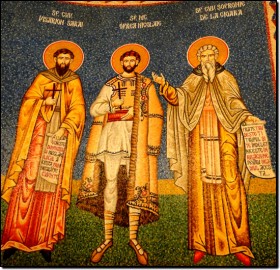Five Saints – Confessors: Victims of Catholic ‘Love’
27 Οκτωβρίου 2012
 During the 18th Century, Transylvania was under the occupation of Austro-Hungarian Empire. The Catholics, wishing to recoup their losses after the schism with the Protestants began an offensive against Orthodoxy. They used both violence and diplomacy to subdue the orthodox, which they considered as ‘backward’.
During the 18th Century, Transylvania was under the occupation of Austro-Hungarian Empire. The Catholics, wishing to recoup their losses after the schism with the Protestants began an offensive against Orthodoxy. They used both violence and diplomacy to subdue the orthodox, which they considered as ‘backward’.
Under the pretext of Unia they tried to proselyte them to Catholicism. Their ways are still used to this day. Nevertheless even those days, there were people who were resisting such efforts of massive conversion and became martyrs and confessors. Such people were monks, like Saints Vissarion and Sophroni, who could not tolerate the discrimination suffered by those orthodox people who were not following Unia and were treated as second class citizens.
Thus they dedicated their lives assisting their neighbor and restoring the orthodox faith in Transylvania.
There were also some brave priests who did their utmost to protect their flock like Fathers John of Gales and Moses of Simbiel. Some were even ordinary peasants who had abandoned their families and property and ended up in the prisons of the ‘modern and enlightened’ Austro-Hungarian Empire, like the Saint- martyr Oprea Miklaus.
The 21st of October has been established as the commemoration day of the Saints-Confessors of Ardeal, Vissarion and Sophroni, the Saint-martyr Oprea Miklaus and the saint-hierormartyrs Moses of Simbiel and John of Gales.
The life of Saint Vissarion.
Vissarion Sarai was born in today’s Bosnia Herzegovina. After visiting the Holy land and Mount Athos he arrived in Carlovatz. The Serb Patriarch sent him to Transylvania to preach to the orthodox against Unia. He crossed the country from one end to the other. Somewhere between Simbiou and Salitse he was arrested. After an all night interrogation he was sent to the horrid prison of Kufstein on the Alps of Tyrol where he died as a confessor of the orthodox faith.
The life of Saint Sophroni of Ciara.
St Sophroni was the monk who led the revolution against the Austro-Hungarian rule in 1759-1761 and opposed the Unitic Episcopi of Blatz, which was waging the war against the Orthodox Church.
He was born in Ciara of Alba and was a married priest. When his wife died, he built a skete outside Ciara. After the authorities burnt it to the ground he launched a struggle against them lasting for two years.
He organized a large group of Orthodox priests and laymen in Alba Julia which served as the stepping stone for a larger future organization of the Orthodox Church. Let’s remember here that ever since 1701 the Romanian Orthodox Church did not have a Bishop.
After a meeting with general Nicolaus Adolf Bucow (who had demolished all Orthodox monasteries) St Sophroni withdrew to Moundenia. He died either in the Veroshi or the Rombaia monastery. The exact date of his repose is not known.
The Orthodox Church of Romania recognized him as a Saint having taken into account his painstaking struggles in favor of Orthodoxy.
The life of Saint Martyr Oprea Miklaus.
He was born in Salistze of Simpiu. He travelled to Vienna on several occasions requesting from Empress Maria Theresa to grant equal rights to the orthodox Christians of Transylvania.
During one such visit he was arrested in 1752 and died in the prison of Kufstein as a confessor of the orthodox faith.
The life of Saint-Martyr Moses of Simbiel
He was recognized as a Saint by the Orthodox Church of Romania in 1992 along with Saint Martyr Oprea Miklaus. He was a married priest. We know that he also travelled to Vienna and died in the Kufstein prison.
The life of Saint hieromartyr John of Gales
St John was a married priest. During 1756-1757 he traversed the entire Transylvania region collecting signatures in favor of equal rights and freedoms for the orthodox people. He was arrested in Kratz and died in prison. We know that 24 years into his imprisonment, some Romanian merchants from Brasov visited him, after learning that an orthodox priest was rotting in prison for many years.
In a discussion with them, St John confessed that he was enduring this suffering for Christ for 24 years and that he had remained steadfast to his faith.
Source: http://proskynitis.blogspot.gr/
Translated into English by: Olga Konnaris-Kokkinos



